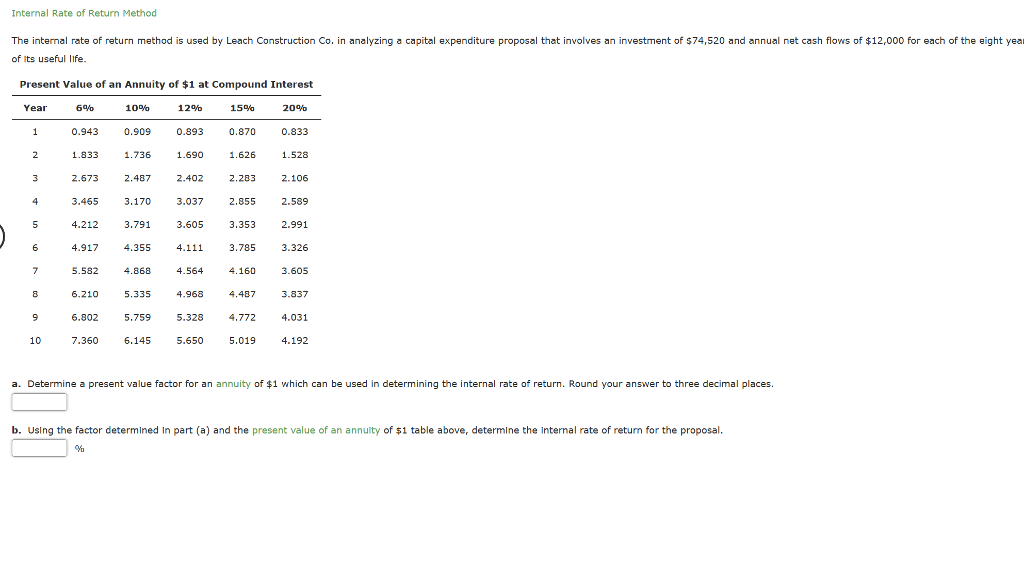
You can quickly resolve the previously discussed mathematical problem by placing the values from the question into our calculator. If you want to calculate IRR using Excel, you can use the IRR function. Pete Rathburn is a copy editor and fact-checker with expertise in economics and personal finance and over twenty years of experience in the classroom. Charlene Rhinehart is a CPA , CFE, chair of an Illinois what is form 720 where to get how to fill out CPA Society committee, and has a degree in accounting and finance from DePaul University. Based on the completed output for our exercise, we can see the implied IRR and MoM at a Year 5 exit – the standard holding period assumption in most LBO models – is 19.8% and 2.5x, respectively. Note that for the formula to work and be dragged down, the date selection must be anchored in Excel, i.e. fixed (Press F4).
How is the IRR calculated?
They measure the viability of investment and projects made by a business. Generally, a higher IRR is better, since it points to greater expected returns for a project. However, investors should keep in mind that IRR has its limitations, so they should use it along with other financial metrics, for example NPV, before making any decisions. IRR can help you evaluate the potential of a new investment or endeavor, as well as compare it with other options you might be considering.
Is there any other context you can provide?
The IRR is uniform for investments of different types and, as such, can be used to classify multiple potential investments or projects on a relatively uniform basis. In general, when comparing investment options with other similar characteristics, the investment with the highest IRR would likely be considered the best. At times, the initial investment gives a small IRR value but a greater NPV value. It happens on projects that provide profits at a slower pace, but these projects may benefit in enhancing the organization’s overall value.
- Practically, such an interest rate guarantees that the money you would invest in such a project today will earn you precisely $0.
- Conversely, if the IRR on a project or investment is lower than the cost of capital, then the best course of action may be to reject it.
- In choosing the second discount rate, though, remember what was said above about trying to gain one positive and one negative NPV.
- The ROI might tell an investor the actual growth rate from start to finish, but it takes the IRR to show the return necessary to take out all cash flows and receive all of the value back from the investment.
- As the cash inflows for the project are an annuity, there is actually a short cut that we can take for the calculation.
What Does a Negative NPV Indicate?

IRR is best used when comparing investments with similar durations and in tandem with other analyses, such as payback period and net present value (NPV). You can also use CAGR, but IRR will be a better representation of an investment’s performance. As Daniel Garza, CFA, who manages a research team at registered investment advisor Corient explains, “IRR is often used to determine the feasibility of investment projects.” Here, our assumption is that exit proceeds increase by a fixed amount of $25 million each year, starting from the initial investment amount of $85 million. The value of the initial investment stays unchanged regardless of which year the firm exits the investment.
IRR vs. Return on Investment (ROI)
Moreover, unlike capital budgeting, the hurdle rate is not compulsory for IRR because companies can compare the IRRs of different projects to find the most suitable investment option. A project can be deemed worthwhile merely by determining if its internal rate of return is more than costs. The internal rate of return (IRR) is a financial metric used to assess the attractiveness of a particular investment opportunity. When you calculate the IRR for an investment, you are effectively estimating the rate of return of that investment after accounting for all of its projected cash flows together with the time value of money. When selecting among several alternative investments, the investor would then select the investment with the highest IRR, provided it is above the investor’s minimum threshold.
Rather, they will likely pursue projects with the highest difference between IRR and RRR, as these will likely be the most profitable. If only IRR 1 was calculated, then the project would be rejected as the target is higher, but if IRR 2 was calculated, the project would be accepted. So when a project has two IRRs, there is ambiguity as to whether the project should be accepted or not.
The drawback to the Excel IRR function is the implicit assumption that precisely twelve months separate each cell. Unlike the IRR Function in Excel, the XIRR function can handle complex scenarios that require taking into account the timing of each cash inflow and outflow (i.e. the volatility of multiple cash flows). A company’s discount rate is typically derived from its cost of capital, or the cost a company pays investors in exchange for capital, either in interest from issued debt or through selling equity in the company.
Another way of putting that is that the upfront cost of the initial investment is equal to the present value of its future cash flows, and since these two are equal, the net present value is zero. IRR can be calculated and used for purposes that include mortgage analysis, private equity investments, lending decisions, expected return on stocks, or finding yield to maturity on bonds. The Excel XIRR function is preferable over the IRR function as it has more flexibility by not being restricted to annual periods. Under XIRR, daily compounding is assumed, and the effective annual rate is returned. But for the IRR function, the interest rate is returned assuming a stream of equally spaced cash flows.
